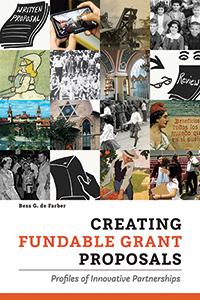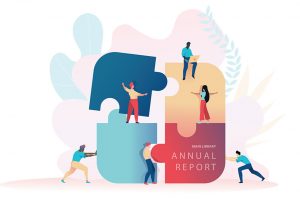
Grant proposals that include partnerships have a significant competitive advantage. Whether these partnerships are with other departments within the same library or with external groups that allow the funder to invest in multiple groups through one grant, collaborations can give you a leg up. But most people have little or no training in developing grant proposals. And to make things more complicated, imagine doing this work with little or no familiarity with those you may want to partner with. For both seasoned and novice grant seekers, and for applicants and their partners, the following steps demystify the partnership process.
1: Create a workflow

When a team wants to submit a grant proposal, it should first ask this question: Do we know the review and approval steps and authorities within our organization who are required to sign off on the proposal prior to submission? If the answer is no, then ascertaining this information will be the first step.
A problem with grant seeking for those who plan to do it for the first time is that it appears to be a deceptively easy process if the guidelines are clear, correct, and complete. But if one simply followed the guidelines as offered by the sponsor and had a version ready 24 hours prior to the deadline, there would be insufficient time to share the proposal with the necessary approvers within the organization. That’s because the process requires time to read and fully understand the proposal—especially its budget—and opportunity for feedback and corrections.
The key step to submitting any grant application? Make sure the organization’s administrators have endorsed the feasibility of a project. Administrators and others in an organization who are assigned extra work that results from “surprise” grant projects can possibly sabotage a grant-seeking culture. Accordingly, organizations should try to maximize transparency about grant projects that are in development well in advance of the approval process.
2: Find funding opportunities
Personnel interested in grant seeking should be provided with a periodic list of deadlines for funding opportunities. If a few librarians dedicated one hour biweekly to a search, they would uncover a treasure trove of opportunities.
To do this effectively, those searching must be aware of the organization’s inherent assets, the interests of its employees, and past project themes on which to build. Creating an asset map of resources, projects, past sponsors of funded proposals, and past published articles is a way to build continuous knowledge of what is happening in an organization that may inspire new proposals for funding, whether internal or external.
3: Workshop funding opportunities
Consider presenting workshops to help others learn about specific sponsors and their funding programs. Federal grant programs, such as those administered by the Institute of Museum and Library Services or the National Endowment for the Humanities, or state libraries’ annual Library Services and Technology Act grant programs, will be good examples to highlight. The guidelines are fairly stable each year, and the programs often announce grant awardees during the funding cycle in a news release, along with abstracts that describe projects being awarded. Analyzing award lists in a workshop setting can help contextualize the types of projects that these sponsors have chosen to invest in.
Participants can be instructed to determine which projects could be replicated in their own organizations. Or they can be asked to think up new projects that might have more benefits and impact because of an innovative element identified within their organization. Groups can categorize the proposals that feature various types of projects, such as research, outreach, literacy, technology, and so on. This will further their understanding of the interests of a particular sponsor in any given year. The process offers a window into funding trends that can be applied to grant application planning efforts.
4: Create a checklist
Sponsor guidelines, including the application itself, are not uniform in quality. Many people who write sponsor guidelines have never planned, prepared, or written a grant proposal. This means the quality of the proposal can be compromised by the quality of the guidelines. How can you get around this? One way is to translate the application’s guidelines and criteria for evaluation into a checklist of questions to be answered by the project team.
First, start with the narrative components of the application. Create two columns to make a checklist: one for questions to be addressed and another to identify the person who will author the draft responses for each specific question or narrative section. Most guidelines ask the applicant to describe the project’s significance or its outcomes. The applicant’s checklist should convert these statements into questions. Completing this activity will likely generate an excellent blueprint for the grant application’s narrative sections.
5: Find partners and develop an idea
This step can be tricky for those with limited experience with grants. Let’s say your team identifies a funding opportunity that appears promising. It secures the list of previously awarded projects and award amounts, completes its checklist, and is ready to define the project. At this point the team should ask: What assets are readily available to improve the project? Once this list is generated, the team should ask: What assets are potentially available in external organizations that may enhance and improve the quality of the project? Finally, the team should consider: Which asset contributors are potentially available in external organizations that are unknown to the team?
Obviously, the more access the team has to external assets, the less resistance the team will encounter to quickly onboarding new partners. The more interest and excitement the project generates, the more others will want to join.
6: Create a timeline and budget and find partners
The draft timeline is the glue that holds the project together. The more detail available to describe each activity, the more easily prospective partners will be able to visualize and understand the project and their prospective roles in its execution.
Building the draft budget will determine the grant amount to request. The total contributed effort (cost share or in-kind contributions) can be quantified by those involved in executing the timeline, whether the sponsor requires it or not. The estimate should include lump sums to cover expenses that partners may need to participate and to complete the project as envisioned. Compare this amount with previously awarded grants for this specific sponsor. With this information, the team can decide if it is reasonable to invite partners to consider performing a role in the project.
Prospective partners should be asked: Why might you be interested in participating? What do you think you might gain? What do you foresee would be your involvement in the activities outlined in the timeline? Going further, the team can ask: What experiences does your organization have, or what resources would you be able to contribute to the project?
If this conversation is fruitful and all parties feel energized by the opportunity, then the team can ask: Would your organization’s participation require a portion of the funds requested or can participation be contributed as cost share, or a combination of both? After receiving answers to these questions, the team can determine the total amount of grant funds to request. The costs for each partner’s participation in the project are added to the draft budget to decide if the project remains feasible.
The most time-consuming part of the application is writing the narrative section. If there is any chance the project lacks enthusiasm or at least a consensus to move forward, the team should reconsider the narrative. Project members should convene with their respective supervisors and all those involved in the proposal to review the grant application. If it receives positive reviews, the proposal is feasible. The team and its partners can now move forward to prepare the narrative, finalize the timeline and budget, and gather the remaining application materials.
7: Prepare, package, and submit the proposal
It may take months or even a year to get to this point, or it can happen quickly if the assets, application information, and documentation already exist and just need to be combined into a single proposal. First, seek out the elements that are dependent on other partners to complete and are therefore largely beyond the control of the team, such as letters of commitment, letters of support, and key personnel résumés; these are all typical requirements for most proposals.
Packaging the proposal should begin at least 48 hours prior to the internal deadline for institutional authorized review and approval before submission. This should provide sufficient time to catch mistakes or missing documents. It is best to print the entire proposal package and view its elements in hard-copy format prior to submitting it for review. Reading the entire proposal out loud is one of the best ways to find mistakes or sections that are missing information. Seeing it in a printed format can expose all kinds of hidden errors.
8: What to do while waiting
Some review processes can take up to nine months. During that period, a lot can happen. People can change jobs within the organization, retire, or leave for positions elsewhere. Family or medical situations can arise that prevent partner representatives from participating in the project. When these life events occur, applicant team members must be made aware so that contingency plans can accommodate changes in advance.
During this dormant time, the team and its partners can strategize about other funding sources and share plans for attending conferences where partners can meet. They can also share information about other funding awards, the progress made on project activities to prepare for possible funding, or the addition of new personnel who plan to contribute to the project.
9: What to do if you do—or don’t—get the grant
Once the principal investigator is notified of the award or declination, the news should be circulated among the project team, financial management administrators, the institution’s central grants administrators, and partners. If the proposal has been declined, request the grant reviewer’s comments, which should be readily available for all government grant programs. Private foundations traditionally do not share reviewer comments.
In general, there are two types of awards: the full grant award and a partial grant award. For partial awards, the project team and partners must determine if they can complete the project with a smaller award or whether the shortfall can be made up by some other source; what budget items can be reduced; and which budget items, if any, the sponsor expects to be reduced or eliminated. For grant applications receiving either full or partial funding, there likely will be other documents requiring the signatures of the organization’s authorized signatory and the project leader to formally commit to accepting the funds and executing the project under the terms and conditions offered by the sponsor.
The team and its partners should note the dates when reports will be due. Also, it is important to review the timeline of activities with everyone at the start to determine if any dates need adjusting. Scheduling regular grant project meetings with all participants and adopting a communication plan to keep everyone informed should be done in the first month.
10: Celebrate your success
The team and its partners may need time to complete the grant project. Usually a sponsor will specify provisions for how to request a no-cost extension. Keeping tabs on the team’s and partners’ activities and progress will help anticipate situations that may require a grant period extension. Assessing these situations 45–90 days prior to the end of the grant period is essential. Most extensions cover an additional year to complete the project to avoid multiple extension requests.
Monitoring budget expenses throughout the project becomes even more important as the project winds down. The project leader will need to touch base with partners to confirm that all funds will be spent down as planned. Some situations, such as those in which equipment purchases were less than projected or delays occurred in hiring time-limited personnel to execute grant-funded activities, can result in grant funds remaining at the end of the project. By anticipating these occurrences, a request can be made to extend the grant period so that funds can be expended.
Finally, celebrate to acknowledge completing the project. This is an important step. It can boost a sense of community and encourage participants to consider future grant projects. To support a culture of grantsmanship, present a showcase of the team’s grant-funded work during a standalone presentation for staff members in the organization. This presentation can be inspirational and uplifting—sharing stories about what is possible when assets are combined in new ways, when participants offer mutual assistance to activate these assets, and where there is a genuine sense of appreciation for those who have contributed to these efforts.

 BESS G. DE FARBER is grants manager for George A. Smathers Libraries at University of Florida in Gainesville.
BESS G. DE FARBER is grants manager for George A. Smathers Libraries at University of Florida in Gainesville.
